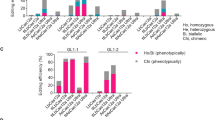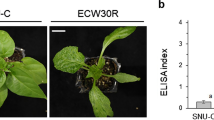Abstract
We compared the sequence of a 96.7 Kb-long BAC clone (B19N3) from Brassica oleracea (broccoli) with its corresponding regions in Arabidopsis thaliana. B19N3 contains eight genes and 15 transposable elements (TEs). The first two genes in this clone, Bo1 and Bo2, have its corresponding region at the end of chromosome V of Arabidopsis (24 Mb). The third gene, Bo3, corresponds to an ortholog at the opposite end (2.6 Mb) of the same chromosome. The other five genes, Bo4 to Bo8 also have a corresponding region on the same chromosome but at 7.7 Mb . These five genes are colinear with those found in the corresponding region of Arabidopsis, which contains, however, 15 genes. Therefore, a cluster of 10 genes is missing in B. oleracea clone (B19N3). All five genes in common have the same order and orientation in the genomes of both species. Their 36 exons constituting the eight homologous genes have high conservation in size and sequence identity in both species. Among these, there is a major gene involved in aliphatic glucosinolate biosynthesis, BoGSL-ELONG (Bo4). Similar to A. thaliana, this gene, has a tandem duplicate, Bo5. A contig for this region was constructed by primer walking and BAC-end-sequencing, revealing general gene colinearity between both species. During the 20 million years separating A. thaliana from B. oleracea from a common ancestor both genomes have diverged by chromosomal rearrangements and differential TE activity. These events, in addition to changes in chromosome number are responsible for the evolution of the genomes of both species. In spite of these changes, both species conserve general colinearity for their corresponding genes.


Similar content being viewed by others
References
AGI (2000) Analysis of the genome sequence of the flowering plant Arabidopsis thaliana. Nature 408:796–815
Altschul SF, Madden TL, Schaffer AA, Zhang J, Zhang Z, Miller W, Lipman DJ (1997) Gapped BLAST and PSI-BLAST: a new generation of protein database search programs. Nucleic Acids Res 25:3389–3402
Babula D, Kaczmarek M, Barakat A, Delseny M, Quiros C, Sadowski J (2003) Chromosomal mapping of Brassica oleracea based on ESTs from Arabidopsis thaliana: complexity of the comparative map. Mol Genet Genom 268:656–665
Bancroft I (2001) Duplicate and diverge: the evolution of plant genome microstructure. Trends Genet 17:89–93
Burge C, Karlin S (1997) Prediction of complete gene structures in human genomic DNA. J Mol Biol 268:78–94
Cavell AC, Lydiate DJ, Parkin IAP, Dean C, Trick M (1998) A 30 centiMorgan segment of Arabidopsis thaliana chromosome 4 has six collinear homologues within the Brassica napus genome. Genome 41:62–69
Flicek P, Keibler E, Hu P, Korf I, Brent MR (2003) Leveraging the mouse genome for gene prediction in human: from whole-genome shotgun reads to a global synteny map. Genome Res 13:46–54
Gao M, Li G, Yang B, McCombie WR, Quiros CF (2004a) Comparative analysis of a Brassica BAC clone containing several major aliphatic glucosinolate genes with its corresponding Arabidopsis sequence. Genome 47(4):666–679
Gao M, Quiros CF, McCombie WR, Nascimento L, Balija V, Bell M, de la Bastide M, Spiegel L, Zutavern T, Muller S, Miller B, Katzenberger F, Andrade MV, Dike S, O’Shaughnessy A, Palmer LN (2004b) Genomic sequence for broccoli [Brassica oleracea L. (italica group)] BAC clone B19N3, complete sequence. NCBI submission AC149635. Genomic sequence gi: 48762521. http://www.ncbi.nlm.nih.gov/
Gribbon BM, Pearce SR, Kalendar R, Schulman AH, Paulin L, Jack P, Kumar A, Flavell AJ (1999) Phylogeny and transpositional activity of Ty1-copia group retrotransposons in cereal genomes. Mol Gen Genet 261:883–891
Kowalski SP, Lan TH, Feldmann KA, Paterson AH (1994) Comparative mapping of Arabidopsis thaliana and Brassica oleracea chromosomes reveals islands of conserved organization. Genetics 138:499–510
Kroymann J, Textor S, Tokuhisa JG, Falk KL, Bartram S (2001) A gene controlling variation in Arabidopsis glucosinolate composition is part of the methionine chain elongation pathway. Plant Physiol 127:1077–1088
Kroymann J, Donnerhacke S, Schnabelrauch D, Mitchell-Olds T (2003) Evolutionary dynamics of an Arabidopsis insect resistance quantitative trait loci. PNAS 100:14587–14592
Lagercrantz U (1998) Comparative mapping between Arabidopsis thaliana and Brassica nigra indicates that Brassica genomes have evolved through extensive genome replication accompanied by chromosome fusions and frequent rearrangements. Genetics 150:1217–1228
Lan TH, Del Monte TA, Reischmann KP, Hyman J, Kowalski SP, McFerson J, Kresovich S, Paterson AH (2000) An EST-enriched comparative map of Brassica oleracea and Arabidopsis thaliana. Genome Res 10:776–788
Li G, Quiros CF (2002) Genetic analysis, expression and molecular characterization of BoGSL-ELONG, a major gene involved in the aliphatic glucosinolate pathway of Brassica species. Genetics 162:1937–1943
Li G, Gao M, Yang B, Quiros CF (2003) Gene to gene alignment between the Brassica and Arabidopsis genomes by transcriptional mapping. Theoret Appl Genet 107:168–180
Lukens L, Zou F, Lydiate D, Parkin I, Osborn T (2003) Comparison of a Brassica oleracea genetic map with the genome of Arabidopsis thaliana. Genetics 164:359–372
O’Neill CM, Bancroft I (2000) Comparative physical mapping of segments of the genome of Brassica oleracea var. alboglabra that are homoeologous to sequenced regions of chromosomes 4 and 5 of Arabidopsis thaliana. The Plant J 23:233–243
Quiros CF, Paterson AH (2004) Genome mapping and analysis in Brassica. In: Pua EC, Douglas CJ (eds) Biotechnology in Agriculture and Forestry, 54:31–42
Quiros CF, Grellet F, Sadowski J, Suzuki T, Li G, Wroblewski T (2001) Arabidopsis and Brassica comparative genomics: sequence, structure and gene content in the ABI1-Rps2-Ck1 chromosomal segment and related regions. Genetics 157:1321–1330
Rutherford K, Parkhill J, Crook J, Horsnell T, Rice P, Rajandream MA, Barrell B (2000) Artemis: sequence visualization and annotation. Bioinformatics 16:944–945
Ryder CD, Smith LB, Teakle GR, King GJ (2001) Contrasting genome organization: two regions of the Brassica oleracea genome compared with collinear regions of the Arabidopsis thaliana genome. Genome 44:808–817
Salzberg SL, Pertea M, Delcher AL, Gardner MJ, Tettelin H (1999) Interpolated Markov models for eukaryotic gene finding. Genomics 59:24–31
San Miguel P, Bennetzen JL (1998) Evidence that a recent increase in maize genome size was caused by the massive amplification of intergene retrotransposons. Ann Bot 82:37–44 [CrossRef][ISI]
SanMiguel P, Tikhonov A, Jin Y-K, Motchoulskaia N, Zakharov D, Melake-Berhan A, Springer PS, Edwards KJ, Lee M, Avramova Z (1996) Nested retrotransposons in the intergenic regions of the maize genome. Science 274:765–768
Suoniemi A, Anamthawat-Jonsson K, Arna T, Schulman AH (1996) Retrotranposon BARE-1 is a major dispersed component of the barley (Hordeum vulgare L.) genome. Pl Mol Biol 30:1321–1329
Vicient CM, Kalendar R, Anamthawat-Jonsson K, Suoniemi A, Schulman AH (1999) Structure, functionality, and evolution of the BARE-1 retrotransposon of barley. Genetica 107:53–63
Yang YW, Lai KN, Tai PY, Li WH (1999) Rates of nucleotide substitution in angiosperm mitochondrial DNA sequences and dates of divergence between Brassica and the other angiosperm lineages. J Mol Evol 48:597–604
Zhang X, Wessler S (2004) Genome-wide comparative analysis of the transposable elements in the related species Arabidopsis thaliana and Brassica oleracea. PNAS 101:5585–5594
Acknowledgements
We are indebted to Dr. Lidia Nascimento from Cold Spring Harbor Laboratory for reception and sequencing coordination of BAC clone B19N3, to Ms Bo Yang and Mr Vincent D’Antonio for technical assistance. Research supported by USDA-IFAFS grant# 00-52100-9683. “Development of Genomic Tools and Resources for Brassica” . The sequencing was funded under NSF grant NSF DBI 9813578:“ A Genetic Approach to Ordered Sequencing of Arabidopsis”.
Author information
Authors and Affiliations
Additional information
Communicated by C. Möllers
Rights and permissions
About this article
Cite this article
Gao, M., Li, G., McCombie, W.R. et al. Comparative analysis of a transposon-rich Brassica oleracea BAC clone with its corresponding sequence in A. thaliana . Theor Appl Genet 111, 949–955 (2005). https://doi.org/10.1007/s00122-005-0029-9
Received:
Accepted:
Published:
Issue Date:
DOI: https://doi.org/10.1007/s00122-005-0029-9




